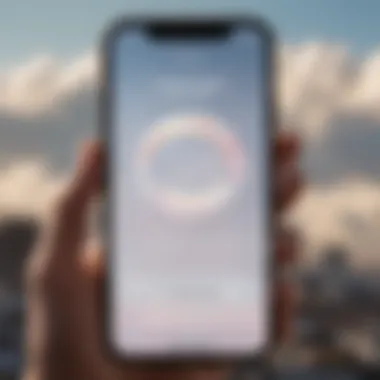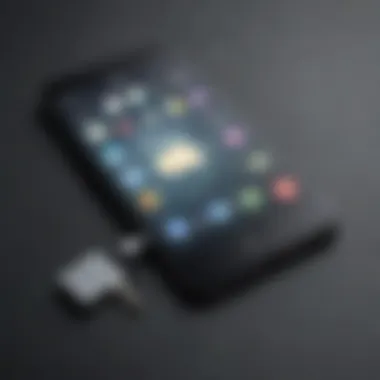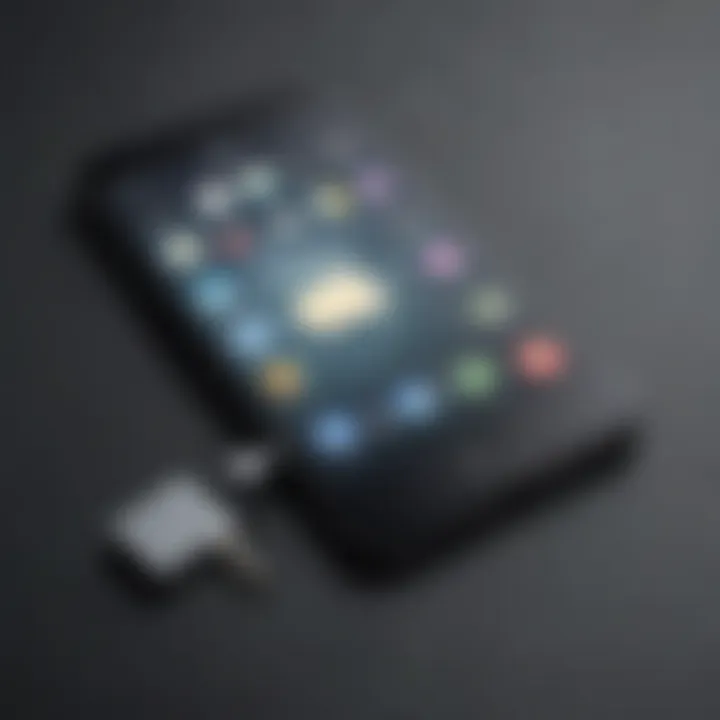Unlocking iCloud Locked iPhone: The Complete Guide


Intro
Unlocking an iCloud locked iPhone can pose challenges for many users. This issue arises mainly when a device is lost or stolen, locking it into its previous owner’s Apple ID account. As Apple prioritizes user security, iCloud activation lock can prevent unauthorized access. Understanding how to navigate this situation is essential, whether one is the device's original owner or a second-hand buyer. This guide aims to dissect various methods to unlock the iPhone while addressing the legal, ethical, and security implications involved in the process.
Product Overview
Prelims to the Apple product being discussed
The iPhone represents a significant evolution in mobile technology, integrating hardware and software in a unique manner. Each model contains distinct features that contribute to its reputation as a premium smartphone. The iCloud locking mechanism is a part of Apple's strategy to secure devices against theft and unauthorized usage.
Key features and specifications
Some salient features of iPhones include:
- iOS: A robust operating system optimized for performance and security.
- Face ID or Touch ID: Advanced biometric authentication for improved security.
- Camera Systems: High-quality cameras with innovative photography capabilities.
- App Ecosystem: A diverse range of applications available through the App Store.
Design and aesthetics
Apple’s design philosophy leans heavily towards minimalism. The aesthetics often feature:
- Sleek aluminum or glass body
- Retina Display with vibrant colors
- Simple yet intuitive user interface
These attributes contribute to the brand's desirability and market position.
Understanding iCloud Locking
iCloud locking serves as a protective measure. It connects the device with an Apple ID, making unauthorized use impossible. Reasons for such locking include:
- Lost Device: Original owners may lock their iPhones to prevent access by others.
- Stolen Device: This feature enhances security after theft and deters resale attempts.
Awareness of the circumstance surrounding the locking is essential for potential unlocking methods. Understanding how Apple prioritizes security while balancing user experience is crucial.
Legal and Ethical Implications
Unlocking an iCloud-locked iPhone involves navigating a complex landscape of legal and ethical considerations. While users may seek legitimate methods, they must also be wary of scams and illegitimate services that promise quick fixes at a cost.
It is important to:
- Verify ownership documentation if trying to unlock the device.
- Understand local laws regarding device unlocking.
- Assess the reliability of third-party services.
"Attempting to bypass iCloud locks through unauthorized means can lead to more severe complications, including permanent device disabling."
End
This guide does not only explore methods to unlock iPhones but also emphasizes the importance of operating within legal and ethical boundaries. As technology continues to evolve, understanding these mechanisms will be vital for users aiming to gain access to their devices.
Knowing the steps involved, alongside the consequences of each action, will empower users in their pursuit of unlocking an iCloud locked iPhone. Further sections will outline specific methods, detailed procedures, and additional insights to facilitate this complex process.
Understanding iCloud Lock
In the realm of Apple devices, iCloud lock serves as a significant barrier to unauthorized access and use. Understanding iCloud lock is crucial for users, especially those acquiring second-hand devices. When an iPhone is locked to an iCloud account, accessing its features becomes increasingly complicated without the proper credentials. This protection mechanism is essential for safeguarding personal data and preventing theft.
Moreover, the implications of an iCloud lock extend beyond mere access to the device. Realizing the potential scenarios that can lead to iCloud lock is vital for any user, as it equips them with knowledge on how to handle such situations. It also shapes the potential decisions on how to retrieve or unlock the device properly without infringing on ethical standards.
What is iCloud Lock?
iCloud lock is a security feature embedded in Apple's operating system. It is designed to prevent unauthorized access to an iPhone, iPad, or any device linked with an Apple ID. When a device is locked, it requires the original owner's Apple ID and password to unlock. The primary goal behind this feature is to deter theft and secure personal information stored on the device. Upon enabling Find My iPhone, users automatically activate iCloud lock, enhancing the level of protection in case of loss or theft.
How iCloud Lock Functions
The function of iCloud lock hinges on linking the device to a specific Apple ID. Upon activation, the device checks its status on Apple's server. If the device is reported as stolen or lost, the iCloud lock activates, rendering the device unusable without the correct credentials. This process operates through Apple's cloud service and ensures that only the rightful owner can unlock the device. This connection means that the user must recall their Apple ID credentials, including the email address and password used during the initial setup.
Common Scenarios Leading to iCloud Lock
Several circumstances may result in an iCloud lock. Understanding these scenarios is vital, as each situation may demand a different approach for resolution:
- Purchasing a second-hand device: If the previous owner failed to remove their Apple ID from the device, the new user faces immediate iCloud lock.
- Forgotten credentials: Users often forget their Apple ID or password, leading to unintentional iCloud lock.
- Device theft: If a device is stolen and the owner enables Find My iPhone, it locks the device automatically for security reasons.
- Software issues: Sometimes, updates or software glitches can lead to an unresponsive system that triggers iCloud lock as a safety precaution.


Recognizing these scenarios helps users to understand the implications tied to their devices and guides them toward appropriate unlocking methods.
Legal and Ethical Considerations
When discussing the topic of unlocking an iCloud locked iPhone, it is crucial to explore the legal and ethical considerations that accompany this process. Understanding these elements is vital for several reasons. First, ethical dilemmas arise from the possible misuse of unlocking techniques. Engaging in unauthorized access can infringe on an owner’s rights and privacy. Second, the legal implications can lead to severe consequences if laws are violated.
Informing users about the appropriate and unacceptable methods for unlocking is necessary to foster responsible practices. This includes a clear distinction between legitimate and illegitimate approaches. Therefore, examining this section will provide readers with insight into balancing their desires with the respect for existing laws and moral standards.
Legitimate reasons for unlocking must be respected while recognizing that not every action taken to access a locked device is justified. Moreover, understanding the risks associated with unauthorized methods can help users navigate these waters more safely, ensuring they make informed decisions.
Legitimate Reasons for Unlocking
Unlocking an iCloud locked iPhone can happen for various legitimate reasons. Users may find themselves unable to access their own devices due to forgetfulness or changes in ownership. Often, users might not have realized that their device was locked when purchased second-hand. Here are some common legitimate scenarios:
- Forgotten Apple ID or Password: Many users may forget their Apple ID credentials, making their devices unusable.
- Purchase of a Second-Hand Device: Users may acquire a locked iPhone without proper disclosure from the seller, needing to unlock it to use.
- Traveling Abroad: If a user is traveling and wants to use a local SIM card, unlocking may be necessary to access different networks.
- Device Recovery: In case of theft or loss, proving ownership and unlocking may restore access to important data and services.
In these instances, pursuing a legitimate unlocking process is warranted, ensuring that the user acts within the law. To navigate these scenarios, employing the appropriate channels is crucial, usually involving Apple’s support or the previous owner’s assistance.
Risks of Unauthorized Unlocking Methods
While various methods exist for unlocking an iCloud locked iPhone, many involve unauthorized techniques. These methods often tempt users looking for quick solutions but come with risks that can overshadow the benefits. Here are a few risks to consider:
- Legal Consequences: Engaging in unauthorized unlocking can lead to legal repercussions. Depending on jurisdiction, it may be considered a violation of computer access laws.
- Loss of Data: Unauthorized tools and methods can lead to data corruption, potentially making the device inoperable or losing valuable personal data.
- Security Vulnerabilities: Many third-party services and tools may introduce malware or security risks. This poses a threat not only to the device but also to the personal data stored within.
- IoS Updates and Support Issues: Devices that undergo unauthorized unlocking may not receive future iOS updates. This could leave the iPhone vulnerable to security exploits or bugs.
It’s essential to evaluate the source and method carefully before proceeding with unlocking options.
By understanding the risks involved with unauthorized methods, users can protect themselves from potential traps. It is best to prioritize security and legality when considering unlocking an iCloud locked iPhone.
Official Methods for Unlocking an iCloud Locked iPhone
Official methods for unlocking an iCloud locked iPhone are crucial for those facing the challenges of device access. This section emphasizes the legitimacy and efficacy of methods that comply with Apple's guidelines. Relying on official support ensures that users do not fall into legal or ethical gray areas. Furthermore, official processes typically guarantee that device data remains intact and secure.
Using the proper channels can enhance the likelihood of a successful unlock, fortifying the user’s trust in their device. This topic is particularly relevant to Apple aficionados and tech professionals. They often deal with activation issues or assist users in navigating the complexities surrounding iCloud locks.
Using Apple's Official Support
When dealing with an iCloud locked iPhone, turning to Apple's official support is often the most reliable solution. This avenue provides access to trained Apple technicians who understand the intricacies of the iCloud systems. The first step is to visit the Apple support website or an authorized service center.
Users should prepare necessary information about the iPhone, like the device's serial number and any proof of purchase. This documentation is critical for verifying ownership and expediting the unlocking process. Apple's support team will guide users through the steps, which generally include a verification process for the associated Apple ID.
It's essential to document all communications with Apple for future reference.
Verification Requirements
Verification is a key component when pursuing official methods for unlocking an iCloud locked iPhone. Apple takes security very seriously and requires users to follow specific protocols to protect devices from unauthorized access. Users will usually need to provide a valid Apple ID and demonstrate ownership of the device.
Typical verification requirements may include:
- Proof of Purchase: A receipt or invoice showing the original purchase from an authorized retailer.
- Apple ID Information: Users must be able to access the Apple ID associated with the device.
- Security Questions: Answers to security questions may be required to confirm the identity of the user.
Failure to comply with these verification requirements may lead to prolonged unlocking processes or outright denial of assistance from Apple's support team. Therefore, it is paramount to ensure that all information is accurate and readily available before making contact.
Unlocking via Previous Owner Assistance
Unlocking an iCloud locked iPhone through the assistance of the previous owner is a practical approach that many users may overlook. This method has advantages, especially when considering the high regard for privacy and security that Apple enforces. By engaging with the previous owner, you can navigate the unlock process in a legitimate manner that is both respectful of ownership rights and compliant with Apple's policies. The importance of this topic lies in the psychological and practical benefits of securing your device without resorting to unauthorized methods.
Contacting the Previous Owner
Reaching out to the previous owner of the iPhone can significantly simplify the unlocking process. This is especially relevant if the device was purchased second-hand. The previous owner's cooperation can lead to a direct resolution. Here are steps to consider when contacting the previous owner:
- Gather Information: Before reaching out, try to gather relevant information about the device, such as model and serial numbers. This will be helpful in discussions.
- Direct Communication: If you bought the device through an online marketplace or social media platform, use those channels to contact the seller. Be clear about your intention and express your need for their assistance in unlocking the device.
- Respect Boundaries: Understand that the previous owner may have their reasons for not wanting to be contacted. Approach them with a polite request without pressing too hard if they seem unresponsive.
The crux lies in fostering effective communication. A straightforward, respectful message can lead to favorable outcomes.
Using the Previous Owner's Apple


If the previous owner is cooperative, they may provide you with their Apple ID and password, allowing you to remove the iCloud lock legitimately. Here’s how you can utilize this information:
- Sign In to iCloud: Use the provided Apple ID to sign in to the iCloud account through the settings on the iPhone.
- Remove Device from Account: Once logged in, navigate to the Settings, select the Apple ID at the top, scroll down to find the iPhone, and remove it from their account. This action is necessary for disabling the iCloud lock.
- Verification Process: The previous owner may be required to verify their identity, possibly through two-factor authentication, if enabled. Ensure they are available for this step.
The entire process can be straightforward if the previous owner is willing to assist. Not only does this respect the rules set forth by Apple, but it also fosters a sense of goodwill. Remember, unauthorized unlocking attempts can lead to serious security risks and potential legal issues, thus reinforcing the importance of cooperating with the original owner.
Third-Party Unlocking Services
Third-party unlocking services have become a practical consideration for many individuals facing iCloud lock issues. While options like reaching out to Apple support or the previous owner exist, these can sometimes be time-consuming or frustrating. Third-party services often claim to offer quicker solutions. However, it is crucial to weigh the pros and cons before making a decision.
Overview of Third-Party Services
Third-party unlocking services are businesses specializing in bypassing iCloud locks on Apple devices. They operate independently of Apple and provide various methods and tools to unlock locked devices. Some may claim quick and guaranteed results, while others might focus on more discreet, less conventional approaches. Here are some key points about these services:
- Speed: Many users prefer third-party services for their ability to unlock devices relatively quickly compared to official methods.
- Variety: There are several services available with differing techniques and levels of success.
- Costs: Prices can vary significantly, making it essential to conduct thorough research.
It is important to note that while these services may seem appealing, they come with their own set of risks and uncertainties.
Evaluating the Reputation of Services
Assessing the reputation of any third-party unlocking service is paramount. Not all services are created equal, and many have a range of reviews and customer experiences. Here are practical steps to evaluate their credibility:
- Customer Testimonials: Look for reviews on forums like Reddit or independent review sites. Genuine feedback can highlight both the strengths and weaknesses of the service.
- Clear Policies: A reputable service should provide transparent terms regarding their unlocking process, success rates, and refunds for unsuccessful attempts.
- Communication: Testing the responsiveness and professionalism of the customer support can provide insights into the business’s reliability.
- Research Their Track Record: Established services often have more experience and a history of successful unlocks. Investigate their website and any reported cases.
Careful evaluation will help mitigate risks associated with third-party unlocking services, ensuring an informed decision.
Potential Risks of Third-Party Unlocking
The allure of third-party unlocking services for iCloud locked iPhones can seem strong. Many individuals seek quick solutions to regain access to their devices and might consider these methods as the easiest way out. However, it is essential to assess the potential risks associated with using such services thoroughly. Understanding these risks is crucial in making an informed decision and safeguarding both your device and personal information.
Security Risks Involved
Utilizing third-party unlocking services poses significant security concerns. These services can often require you to share sensitive information, such as your Apple ID and password. By providing this data, you expose yourself to unauthorized access and potential misuse of your account. Hackers and malicious actors often target individuals seeking unlocks, aiming to capture their credentials. Once information falls into the wrong hands, recovery may be extremely challenging.
Moreover, many of these services do not adhere to Apple’s strict security protocols. This can lead to vulnerabilities on your device, making it susceptible to malware infections or data breaches. Therefore, trusting a third-party service can compromise the integrity of your device and the confidentiality of your personal data.
Potential for Data Loss
Data loss is another serious risk when opting for third-party unlocking methods. When an unauthorized service attempts to unlock your device, there is a possibility that it may involve a factory reset. This procedure wipes all data from the phone, leading to irreversible loss of important information such as photos, contacts, and messages.
Even if data is meant to be preserved, there's no guarantee that the method will work without issues. Many users report losing contacts or media files after using a third-party service. Relying on such services might yield disastrous results, especially for those who have not backed up their data. To avoid this profoundly inconvenient issue, one should always assess the risk of data loss before proceeding with any unlocking methods that involve third parties.
In summary, the risks of third-party unlocking can be severe. Security breaches and potential data loss stand out as significant concerns that every user must weigh critically.
Being informed and cautious can prevent unwanted consequences, ultimately protecting your device and personal information.
iCloud Account Recovery
Recovering an Apple ID is crucial when dealing with an iCloud locked iPhone. When a device is locked due to iCloud activation, the only way to regain access is typically through the associated Apple ID. This section covers the steps necessary to recover your Apple ID and what you need to keep in mind during the recovery process.
Recovering Your Apple
Retrieving your Apple ID is often the first step in recovering access to an iCloud locked iPhone. Apple ID is essential because it links your device to your iCloud account, enabling you to access all Apple services. If you forget your Apple ID, you can retrieve it by visiting Apple’s official site.
- Go to the Apple ID Account Page.
- Click on "Forgot Apple ID or password?".
- Follow the onscreen instructions to check if your email address is linked.
It is important to have access to your email or phone number associated with your Apple ID for this process. If you remembered your Apple ID but have lost your password, you can reset it in the process that follows.
Resetting Passwords
Once you have confirmed your Apple ID, the next action typically involves resetting your password. This password is the key that unlocks your iCloud account. Without it, the iCloud lock remains intact. Here’s how to reset your password:
- Navigate back to the Apple ID Account Page.
- Click "Forgot Apple ID or password?".
- Enter your Apple ID and select the option to reset your password.
- Choose how to reset your password—either via email or security questions.
Resetting your password is a straightforward process, but keep in mind:


- Always ensure you create a strong password that is difficult to guess.
- Make a habit of updating your password periodically for added security.
Successfully recovering your Apple ID and resetting your password is paramount for regaining access to an iCloud locked iPhone. Without this step, other methods to unlock the device may prove futile.
Important Note: Ensure you have documented your Apple ID and password securely, as this reduces future risks of access issues.
Using Activation Lock Bypass Tools
The topic of Using Activation Lock Bypass Tools is significant within the realm of unlocking iCloud locked iPhones. As technology evolves, solutions for bypassing the iCloud lock also emerge. Bypass tools provide methods for users who find themselves locked out of their devices, offering alternatives to traditional unlocking methods. These tools can be appealing as they might seem quicker or sometimes more effective than going through Apple's procedures or contacting previous owners.
However, the benefits of these tools come with caveats. While they may allow immediate access to a locked device, their effectiveness can vary widely. Some tools work well and deliver on their promises, while others may not work at all. In addition, there are important considerations to keep in mind regarding the use of such tools. Security concerns are paramount, as many of these tools require users to download software that could potentially harm the device or compromise personal data.
Moreover, the ongoing risk of scams exists in this space. Users must exercise caution and conduct thorough research before committing to any unlocking tool, ensuring it comes from a reputable source. The potential for data loss and the necessity to back up important content cannot be underestimated.
Overview of Bypass Tools
Bypass tools designed to unlock iCloud-locked iPhones fall into various categories. Some tools are software-based applications that users can download to their computers. Others may be online services that promise to unlock devices through remote access. Here’s an overview:
- Software Solutions: This type may require a computer, as they often involve downloading programs like Tenorshare 4uKey or Dr.Fone.
- Online Services: Some websites offer unlocking services for a fee without needing to download any software. A few popular online options include iCloud Unlocks or iPhone Unlock Zone.
Each of these solutions typically promises to bypass the iCloud lock under specific conditions. The features may include automated processes or guided steps that are designed to assist the user. Users are advised to read reviews and avoid services that seem overly sketchy or provide little customer support.
Legal Implications of Using Such Tools
The legal implications surrounding the use of bypass tools cannot be overlooked. While bypassing the iCloud lock may be seen as a convenient option by some, it is crucial to recognize the ethical and legal boundaries that exist.
Using these tools can potentially violate Apple’s terms of service. Such actions might lead to consequences that include:
- Permanent Device Lock: Attempting unauthorized bypass methods might result in the iPhone being permanently locked if Apple recognizes the action.
- Potential Legal Action: Depending on the jurisdiction, utilizing bypass tools may expose users to legal repercussions, especially if linked to stolen devices.
- Fraudulent Activity: Involving oneself in services that promote illegal unlocks could label users as participants in fraudulent activities.
It’s essential to weigh these risks against the urgency of accessing a locked device. Always consider exploring official avenues before turning to bypass options.
Best Practices for Future Prevention
Preventing the risk of having your iPhone locked by iCloud is critical in today's digital age. There are several best practices that can help avoid this situation in the future. By maintaining accurate account information and securing your devices properly, you can minimize the possibility of running into issues with iCloud Lock.
Maintaining Accurate Account Information
Keeping your Apple ID and iCloud account information current is crucial. Regular updates ensure that you have access to important recovery options and support services. Whenever you change your phone number or email address, make sure to update this information in your account settings. This allows you to receive verification codes and notifications. If you forget your password, up-to-date information eases the recovery process.
- Verify account details: Regularly check that all details are correct.
- Utilize two-factor authentication: This adds an extra layer of security to your account, making unauthorized access much harder.
- Backup account information: Keep a secure note of your credentials in case you need to recover your account.
Keeping Your Device Secure
Device security cannot be overstated. By taking some essential steps to secure your device, you can protect it from theft or unauthorized access. It not only safeguards your personal information but also prevents any accidental iCloud locks. Here are some strategies to ensure your device remains secure:
- Set a strong passcode: A robust passcode significantly hinders anyone from accessing your device without your consent.
- Enable Activation Lock: This feature safeguards your device by requiring your Apple ID and password to deactivate Find My iPhone.
- Be cautious with public Wi-Fi: Unsecured networks can expose your device to risks. Always use a VPN when connecting to such networks.
"Securing your iPhone and maintaining accurate account information are the cornerstones of preventing iCloud Lock issues in the future."
Additionally, be aware of phishing attempts that may try to gather your account information. Always verify the source before entering any sensitive information online.
By implementing these best practices, you can safeguard yourself from the unexpected consequences of an iCloud lock and enjoy a more secure Apple experience.
End
The conclusion of this article serves to encapsulate the multifaceted aspects of unlocking an iCloud locked iPhone. Navigating the complexities of iCloud Lock reflects not only on technological challenges but also on ethical and legal considerations that every user must be aware of. This knowledge plays a crucial role in fostering responsible device ownership and ensuring compliance with relevant laws.
Summarizing Key Points
In summary, we examined several key aspects:
- Understanding iCloud Lock: We discussed what iCloud Lock is and how it functions, highlighting common scenarios that lead to device locking. This foundation is essential for any user facing the problem.
- Legal and Ethical Considerations: It is vital to discern legitimate reasons for unlocking, as well as the risks associated with unauthorized methods. The implications of these choices can have lasting consequences.
- Official Methods: We outlined the steps to take advantage of Apple's official support, emphasizing the importance of appropriate verification requirements to recover access to your device legally.
- Communication with Previous Owners: The necessity of contacting prior owners was discussed, providing clarity on how their cooperation can play a role in the unlocking process.
- Third-Party Services: While these options exist, the potential risks, including security issues and data loss, should not be overlooked.
- Account Recovery: Strategies for recovering an Apple ID and resetting passwords were provided, offering readers practical methods for regaining access.
- Activation Lock Bypass Tools: We addressed the functionality and legal implications of using these tools, encouraging users to proceed with caution.
- Best Practices for Future Prevention: Finally, strategies to maintain accurate account information and ensure device security were shared, underpinning the importance of proactive measures.
These points underline the importance of a thoughtful approach when dealing with iCloud locks.
Final Recommendations
As a final note, the approach to unlocking an iCloud locked iPhone warrants careful deliberation. Here are some recommendations:
- Utilize Official Channels: Always begin with Apple's official support. It reduces the risk of errors and ensures compliance with legal standards.
- Secure All Information: Maintain updated records of account information to prevent future lockouts. This simple step can save a lot of time and resources.
- Avoid Third-Party Services Unless Necessary: If official methods fail, weigh the pros and cons of third-party services carefully. Thorough research is essential before proceeding.
- Educate Yourself: Stay informed about the implications of iCloud Lock through credible resources. Knowledge empowers users to make informed decisions.
- Test Security Regularly: Regularly assess device security and account settings to confirm that everything is in order, mitigating the risk of getting locked again.
By considering the recommendations and key points presented, users can navigate the complexities of iCloud locking with more confidence.



